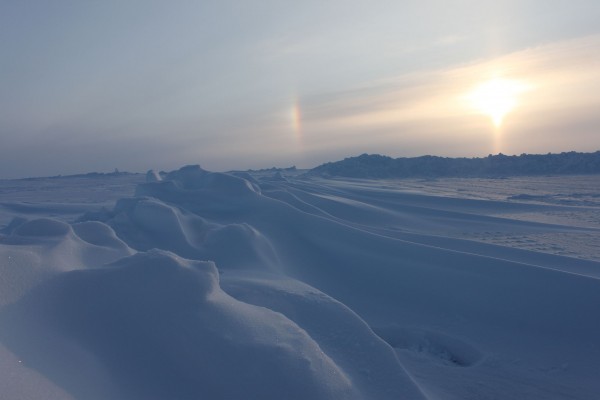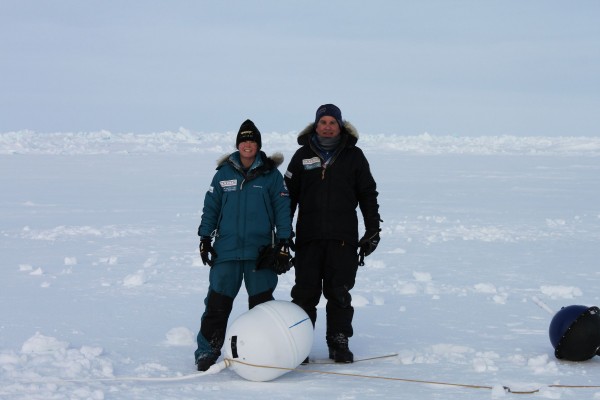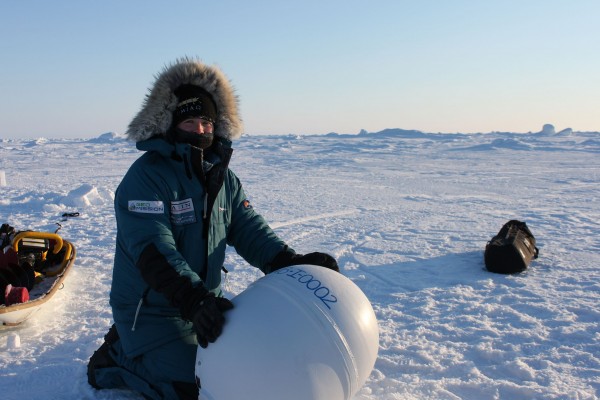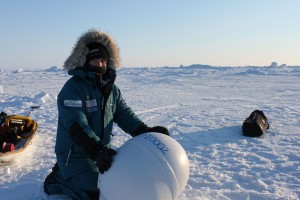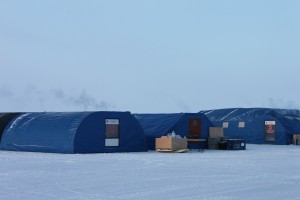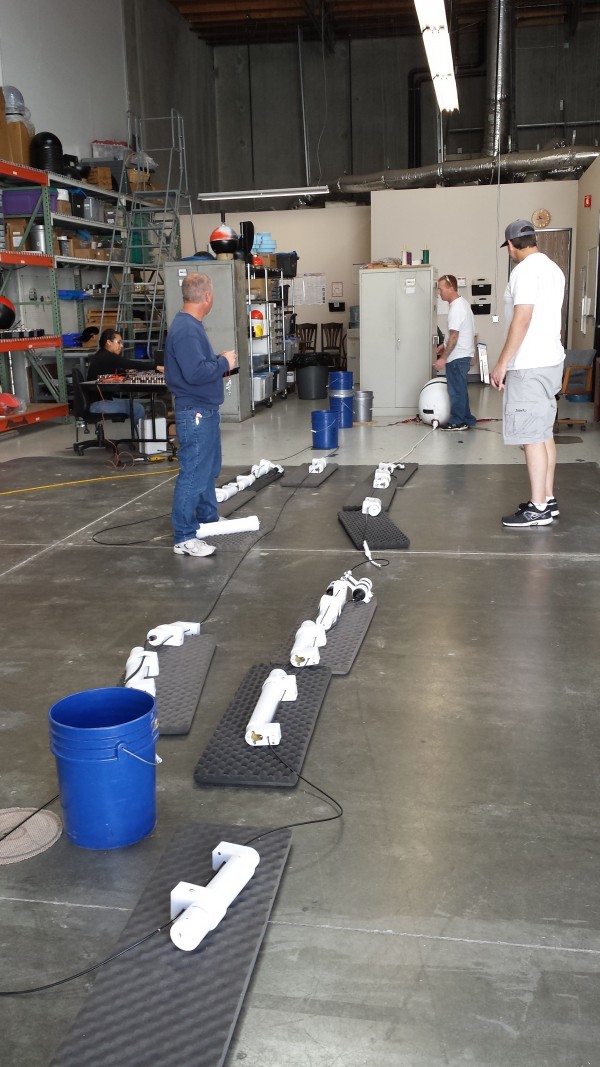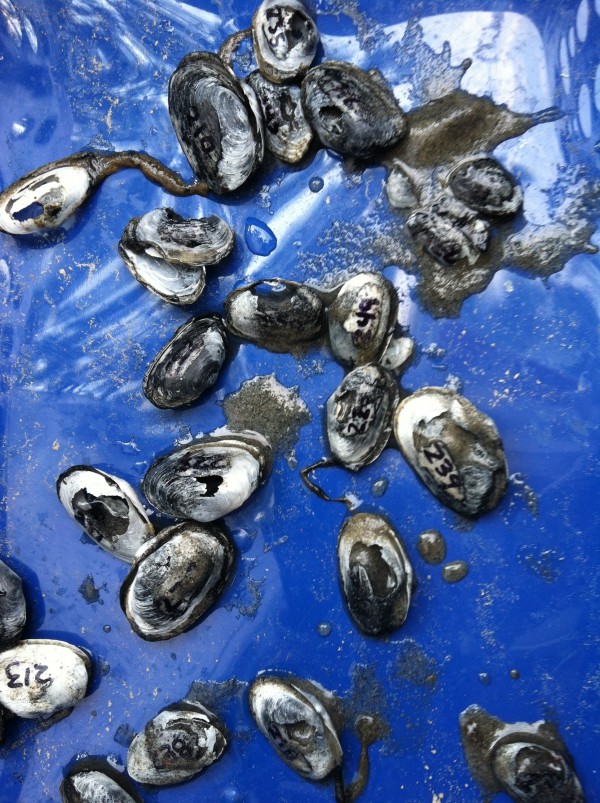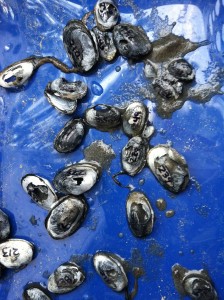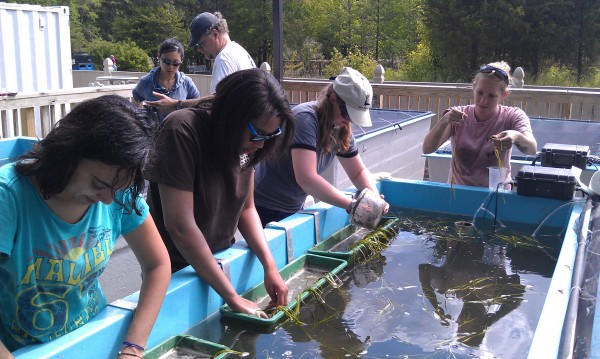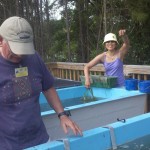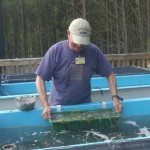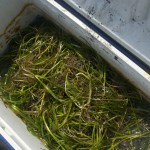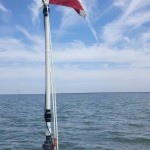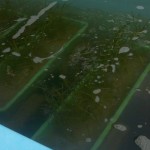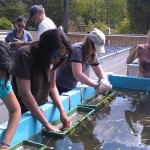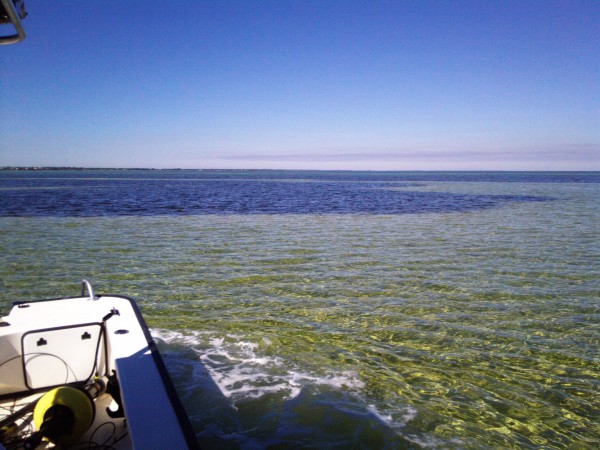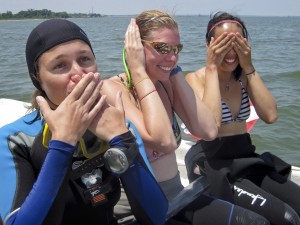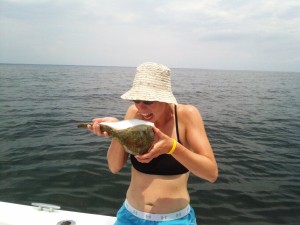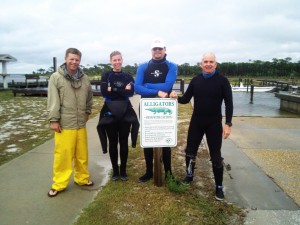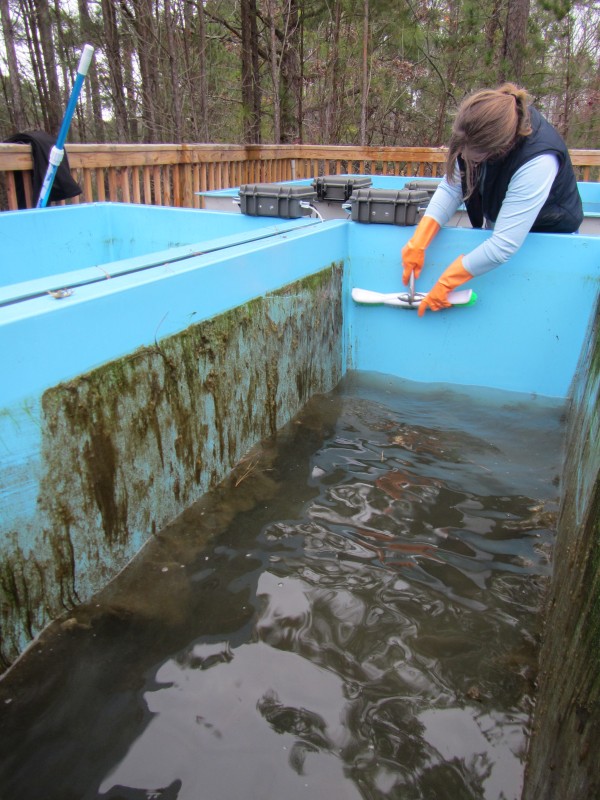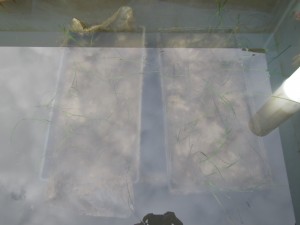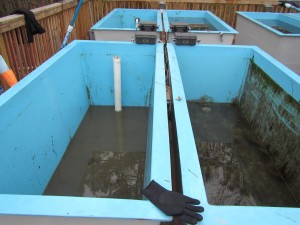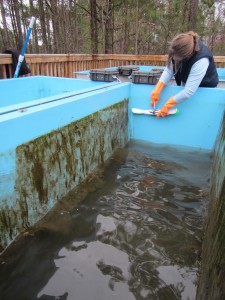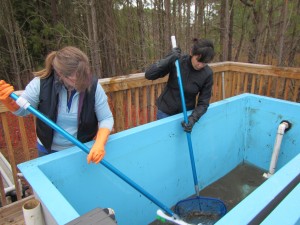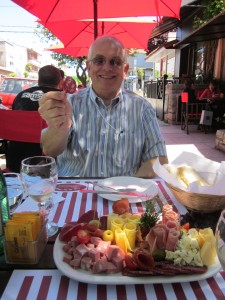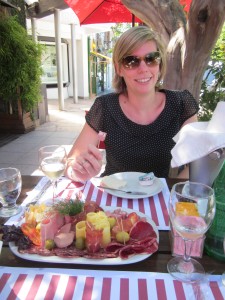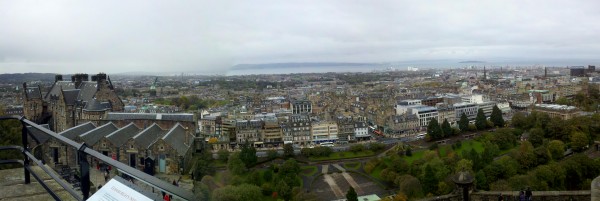Follow this link to see an video of all of the under ice photographs from our Arctic buoys for this season. At first the water looks blue, due to there being very little material absorbing light. In July the water turns the color of peak soup, this is from the presence of a phytoplankton bloom. This was very interesting as the presence of blooms under the ice has only recently been documented. After the bloom the water is again blue in color as the absorbing materials sink out to deeper waters.
Category: Blog
Buoy 1 the journey so far
Here is a short video detailing the adventures of buoy #1 since 9th March. This is the system that we deployed North of Barrow, Alaska. I have named this buoy “Commander Vimes” if you don’t get the reference i highly recommend reading the works of Terry Pratchett.
On the ice at Barneo (North Pole Camp)
Barneo, the North Pole ice camp. Our latitude is 89N and 20E, outside temperature -27oC, you could be fooled into thinking that you are on land, but in fact under the 2 m of ice there is 2,000 m of water. Barneo is a public camp, run by Russians and populated by polar explorers and thrill seekers, plus scientists. To get here you fly through the Norwegian Spitzbergen islands, and it is here that I met up with the group from the University of Washington that operates the North Pole Environmental Observatory. A couple of days to sort through all the equipment that was shipped here over the last year, and we are ready to head to camp. It is a 2.5 hour plane ride to Barneo and we arrive at lunchtime. As I only have 3 days here I was eager to find a location for the buoy and get it deployed. We spent our first day searching the surrounding flows for a good spot. The ideal location is a flat ice pan surrounded by ridges, the fracturing of the floe will most likely occur at these ridges, meaning that as summer progresses and our floe drifts south, our buoys will hopefully stay intact in the middle of the floe. There is plenty of tea, coffee, hot chocolate and cookies available in the mess tent, and we retire there every few hours to warm up and refuel. With my satellite phone I am able to stay in contact with Pacific Gyre and keep them updated on my progress, it also enables me to call home and let everyone know that we are ok. While we are looking for our perfect buoy location, I turn on the WARM buoy GPS, so my colleagues can at least see that our camp is drifting south several miles a day. Each day the plane arrives with more adventurers and several dog teams cycle through the camp. It is always funny, as the dogs are so excited to be on the ice, they start howling when individual dogs are harnessed up, it’s as if they are worried that they will be left out of all the fun!
Sunday comes around and we spend the morning, collecting ice core samples, and measuring light profiles, we are just waiting for a snow mobile team to drag the buoy over to our location. This finally happens at about 4pm local time. We have 24 hours of sunlight so we can work at any time of the day or night. It only takes 30 minutes to unpack all the sensors and feed them down the 10 inch ice hole. After this I call Pacific Gyre to make sure that all the sensors are uploading. Back in California they can even see the crack in the ice from the below ice camera at 20 m. With the news that the buoy is working I can breathe a sigh of relief, and just like that my Arctic field season is over for this year.
While I make my way back home, the rest of the team here have several more buoys to deploy both at camp and at various locations around the pole. I am hoping that I can come back next year, now I have seen the camp, I have some ideas for experiments to conduct while I’m here.
Going to the Arctic
It’s T-1 day until I head to the Arctic toa Russian ice camp near the north pole. I will be deploying an ice teathered buoy with a string of temperature and light sensors. I will be posting video blogs to the wesbite, just look under field blogs Arctic on the top banner.
In the meantime here are a few pictures of the buoy i will be deploying.
Clams and low pH
Becky Walawender from the Department of Biology here at ODU has been monitoring the soft shell clams that were recruited into our tank this spring. Here she describes the results so far.
Soft-shell clams (Mya arenia) have fragile, thin shells made of calcium carbonate and are susceptible to breaking under the acidic conditions associated with excessive carbon dioxide. To test this, we placed 110 soft-shell clams into sediment and monitored their survival in five different pH levels (6.0, 6.5, 7.0, 7.5, 8.0). After two months, we noticed a decrease in survivorship of the clams in pH 6.0. Of the remaining 90 clams in the pH 6 tank (20 were removed for genetic analysis), 55 were confirmed dead, mortality in the other treatments was approximately 6-11 clams. The shells of the dead clams from pH 6.O became brittle and eroded through at the middle, below the umbo.
Shoots, Rhizomes and Roots, oh my!
After a year and a half of planning, construction and wiring we have finally reached the start point of our long-term seagrass ocean acidification experiment. Last week Dick and I spent two days diving in the seagrass meadow in South Bay on the Eastern shore collecting over 1 thousand seagrass shoots to fill our experimental tanks. The rest of the BORG team spent their days cleaning the tanks and awaiting our seagrass booty.
As the plants need to survive and thrive in our tanks we had to collect not just the shoots, but the rhizomes and roots as well. In the muddy sediment of South Bay this required lots of rooting around, so much so that it looked like I had been eating mudpies when I came to the surface!
- Malee planting seagrass
- Dick planting seagrass
- Our seagrass booty
- Diving in South Bay, beautiful
- Team BORG in action
It took three days to plant all of the collection, each tray now has approximately 40 shoots and each tank has between 3 and 5 trays of South Bay grass, some tanks have grasses from Washington State for a side experiment on their tolerance to our warm summers. Now we have wait for a couple of weeks to make sure that the growth rates in all the tanks are the same before we can turn on the CO2 and start the different treatments. We have managed to recruit some folks from both Biology and OEAS to run experiments in our tanks, Becky, a graduate student is going to study the clams that were recruited into the tanks during the spring and Dr Dobbs is going to look at bacterial films.
I will post more details on those experiments once they get started. In the meantime we will all be working on our tans this summer as we spend several days each week tending to our seagrass crop.
Victoria
Meredith Graduates!
Meredith came to us as an undergraduate student, she wanted to gain some experience working in our lab, and brought with her an infectious enthusiasm. During her time with us she has traveled with us to California, Florida and closer to home in the Chesapeake Bay. She already has one publication to her name and is as we speak busy turning her thesis into a manuscript. Her master’s work was focused on the environmental and physiological influences on productivity of eelgrass through δ13C. You can read her defense abstract at the end of this entry. We are all sorry to see Meredith leave us, but she is moving on the new pastures or should we say meadows. One thing that I realized while going through all the pictures of Meredith that I have taken over the past few years is that even when cold, tired and hungry she was always smiling. Now I just have to find a reason to go to a meeting in San Fransico so we can catch up. Victoria
A reflection of lessons learned (post-thesis defense):
Sometimes these types of things are so much more anti-climactic than you hoped they would be.
I would have never gotten to the place I am without so many people around me. Leaving for California in three weeks has left with conflicted emotions. There’s a constant cloud of sadness over my head in the anticipation of leaving my real family, and my school family. All of whom I will miss terribly. However, life is giving me new opportunities for adventure and success, so, I must take them. And what better place than beautiful Northern California, where the hills are so steep that I can’t even ride my bike up them and kelp forests call me to the chilly sea?
I’d like to leave you with 3 lessons I’ve learned over the course of 6 years with the BORG,
- Never be scared to ask for help or admit that you were wrong. You can learn a lot from people when you open up to them.
- Stay at the lab until 2 am to finish those last minute experiments before that meeting that you secretly regret signing up to give an oral presentation at.
- Travel those 5,500 miles to present at a meeting that you’re not even sure if people care about your research because every little bit helps. No matter how expensive it is.
So, goodbye BORG and ODU. It’s been real. And wonderful!
Abstract
Seagrasses’ relatively low capacity to exploit HCO3 as a source of dissolved inorganic carbon (DIC) for photosynthesis forces them to rely extensively on CO2(aq), which is typically present at low concentrations in seawater. As a result, seagrass photosynthesis is generally carbon limited. This study investigated the influence of CO2(aq) transport to RUBISCO, controlled by environmental and physiological mechanisms, on photosynthesis, and the impact on seagrasses stable carbon isotope (δ 13 C) composition. Light saturated photosynthesis (PE) was measured at a variety of flow and DIC regimes to understand carbon uptake at the leaf level, boundary layer conditions, and permeability of the unstirred layer. PE was saturated with respect to increases in flow above ~2.3 cm s-1. The non-linear response of PE to [CO2(aq)] was used to predict the maximum physiological photosynthetic rate (Pm). Stable carbon isotope signature for light-saturated conditions was modeled from the theoretical relationship between PE/Pm and physiological responses to [CO2(aq)] and flow that drive changes in fractionation. Predicted δ13C for flow saturated, ambient [DIC] was ~7‰, well within the range of reported values for seagrasses. Measured δ13C values from the Goodwin Islands were lower than predicted light saturated δ13C. However, when historical epiphyte loading was taken into account, δ13C signatures agreed with published values from similar light-limited environments. The ability to accurately model productivity and δ13C of seagrasses suggests a comprehensive understanding of the influence of light, carbon acquisition, and environmental conditions on photosynthesis.
Cleaning aquarium tanks
The flowing seawater system at the aquarium has been providing our tanks with lovely fresh creek water, the only problem is all the algae that comes with it. The algae foul the sides of the tank as well as the seagrass, and combined with all the leaves that have fallen from the surrounding trees this makes for a lot of crud in the tanks. We need to reduce the fouling as much as possible as it will cover the seagrass and prevent light from reaching the leaves. Once we transplant our seagrass in January we will be at the facility several times a week and keeping the tanks clean on a regular basis. Our mission last week was to get the tanks clean and ready to receive seagrass in the new year. We skimmed all the leaves off the surface, then drained each tank and scrubbed the algae off the sides finishing with scooping all the crud off the bottom. We had two trays of seagrass that we placed in a tank last month as a test, they were heavily fouled and we feared that they would be dead, but under all that algae they were alive and growing, so the good news is that seagrass love our tanks.
The Changing Coastal and Estuarine Environment
It seems somewhat illogical to fly 13 hours on a plane and ride 6 hours on a bus (total trip equaling 27 hours) for a meeting that is only 3.5 days long. However, there was no turning back once we boarded the plane in New York bound for South America. The Coastal Estuarine Research Federation 2012 meeting in Mar del Plata, Argentina was meant to bring the two American continents together, but it also attracted scientists from Europe and Australia – a truly international meeting. It was also a tribute to Scott Nixon, one of the grandfathers to marine ecology, who passed away unexpectedly this year. The small meeting size allowed students and researchers to intermingle over the abundant pastries and drinks provided and tango lessons brought us all dancing together in a small, crowded room. Eating and dancing aside, the CERF 2012 meeting was a huge learning experience for me. With no co-occurring sessions, I was able to listen to a broad range of research topics, from new studies on coastal eutrophication, to the physics of the Plata River, to the fishery rivaries between Chile and Argentina (don’t mess with the Chileans!). More so, I was impressed with the caliber of research presented by the South Americans and their ability to do so much, with much less than most US scientists. My oral presentation was well received, so I now have two meeting presentations under my belt! All in all, it was a great experience and I met several people I plan to stay in touch with throughout my career. I also learned that sometimes it’s worth it to travel 27 hours in the name of science.
Meredith McPherson
Meredith is a masters student with the BORG, she is only a few weeks away from defending her thesis.
Ocean Optics in Glasgow
Dick and I just spent a very productive week at our favourite conference, Ocean Optics. This is a relatively small meeting compared to AGU or ASLO, there were about 2 hundred attendees and with only one session going on at a time you don’t have to make a decision between several interesting talks. I presented my work on Arctic CDOM in sea ice from the Catlin Ice Camp and Dick presented our work on modeling the light availability for seagrass growth in the Chesapeake Bay. I had some very informative talks with the guys from Satlantic and have made my decision on which light sensors to use on my new Arctic buoy system. This meeting is a great way to catch up with friends and colleagues, many of whom I only get to see at this conference. After all the science talk we spent a fun evening at the conference banquet, Dr Alex Cummingham entertained us with a brief history of Scotland, including pictures of the normally shy wild haggis, and a discussion on the Loch Ness monster. We then spent the rest of the night working off dinner with traditional Scottish country dancing. The conference included two very moving tributes to Andre Morel and Charlie Yentsch giants in the world of Ocean Optics who both passed away this year.
